Seville Airport
Seville Airport (IATA: SVQ, ICAO: LEZL)[1] (Spanish: Aeropuerto de Sevilla)[2] is the sixth busiest inland airport in Spain. It is the main international airport serving Western Andalusia in southern Spain, and neighbouring provinces. The airport has flight connections to 42 destinations around Europe and Northern Africa, and handled 7,544,473 passengers in 2019.[3] It serves as a base for the low-cost carriers Vueling and Ryanair.[4] It is 10 kilometres (6.2 mi) east of central Seville, and some 110 kilometres (68 mi) north-east of Costa de la Luz.
Seville Airport Aeropuerto de Sevilla | |||||||||||||
|---|---|---|---|---|---|---|---|---|---|---|---|---|---|
 | |||||||||||||
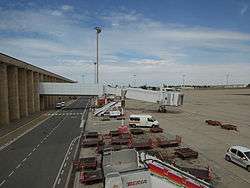 | |||||||||||||
| Summary | |||||||||||||
| Airport type | Public | ||||||||||||
| Owner | Aena | ||||||||||||
| Operator | Aena | ||||||||||||
| Serves | Seville, Andalusia, Spain | ||||||||||||
| Focus city for | |||||||||||||
| Elevation AMSL | 34 m / 112 ft | ||||||||||||
| Coordinates | 37°25′05″N 005°53′56″W | ||||||||||||
| Website | aena.es | ||||||||||||
| Map | |||||||||||||
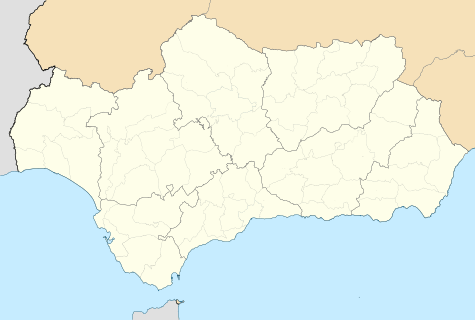 Seville Airport Location within Andalusia | |||||||||||||
| Runways | |||||||||||||
| |||||||||||||
| Statistics (2018) | |||||||||||||
| |||||||||||||
Source: AENA | |||||||||||||
The Seville airport is also known as San Pablo Airport to distinguish it from the older Tablada airport, which was in operation as military aerodrome until 1990.
Facilities
Seville Airport is capable of handling six million passengers a year. There are 23 stands (all of them are self-maneuvering) of which 16 are remote, with 42 check-in desks and 16 boarding gates. Since its last enlargement in 1991 for the Seville Expo '92, the airport has undergone minor extension works. 2013 saw the opening of a new car parking building with five floors. It is currently being remodeled to expand its capacity to ten million passengers a year, completion of the works by 2021.
In the airport grounds there is an Airbus factory (San Pablo Sur), an Airbus maintenance center (San Pablo Norte) and a Ryanair maintenance center.
History
In 1914, the first plane flying between the peninsula and Morocco landed at the improvised aerodrome of Tablada, which had been fitted out the previous year for an air festival. Following this, the municipal government of Seville handed over a plot of land measuring 240,000 m2 (2,600,000 sq ft) to the Military Aeronautical Society for the construction of an aerodrome. Work on the aerodrome began in 1915 and that same year it began to be used for training pilots and observers.
In 1919, the first commercial flights were operated between Seville and Madrid. The following year, an air postal service was established between Seville and Larache and in 1921, the first Spanish commercial service between Seville and Larache was set up. In 1923, various facilities such as hangars, workshops and premises were opened and approval was given for the construction of a municipal airport in Tablada at one end of the military aerodrome airfield, measuring 750 by 500 m (2,460 by 1,640 ft).
In April 1927, Unión Aérea Española established the air service Madrid-Seville-Lisbon. In February 1929, the Seville airport project was approved and in March, the Tablada aerodrome was opened to flights and air traffic. It was decided that this service would cease once the planned airport was constructed.
In 1929, the first flight was operated between Madrid and Seville and in 1930, this was extended to the Canary Islands. In February 1931, the service between Berlin and Barcelona was extended to Seville. In December 1933, LAPE began a service between Seville and the Canary Islands.
During the Spanish civil war, Seville became the arrival point for African troops, whilst Iberia served air transport with flights between Tetuán-Seville-Vitoria, Seville-Salamanca and Seville-Larache-Las Palmas.
In September 1945, works began on the new Seville transoceanic airport in the land area that occupied the old blimp mooring station, which received the last flight in 1936.[5] The works started with construction of runways 05/23, 02/20 and 09/27. One year later, it was classified as a customs point and runways 05/23 and 02/20 were asphalted. In 1948, a goniometer was installed, the runway lighting was completed, and the runways became known as 04/22, 18/36 and 09/27. In 1956, runway 09/27 was extended and runway 18/36 became a taxiway. Tablada was relegated to serve as a military aerodrome, until its closure in 1990.[6]
In 1957, works were carried out on the terminal building and the control tower. Seville Airport was then included in the Hispanic American Agreement for the installation of a supplies base. The facilities were developed near the threshold of 04, rendering the runway out of service.
In 1965, an Instrument Landing System was installed. Between 1971 and 1975, the terminal area was renovated, the apron was extended, a new terminal building was constructed and new access roads were developed.
In 1989, with a focus on the Seville Expo '92, the apron was extended, and a new access from the national motorway N-IV was opened; a new terminal building and a new control tower to the south of the runway were also built. The old terminal was repurposed as a cargo terminal. On 31 July, the new installations were inaugurated.
The new terminal expansion program was begun in 2019 to cope with rapid passenger growth and increase its capacity to 10 million passenger by year.
Airlines and destinations
Passenger
Cargo
| Airlines | Destinations |
|---|---|
| DHL Aviation | Vitoria |
| UPS Airlines | Vitoria |
Statistics
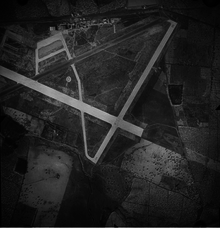

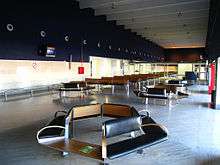
.jpg)
Busiest routes
| Rank | Country | City | Passengers (2013) | Passengers (2014) | Change | Carriers |
|---|---|---|---|---|---|---|
| 1 | Spain | Barcelona | 787,402 | 808,888 | Ryanair, Vueling | |
| 2 | France | Paris | 336,458 | 351,623 | Ryanair, Transavia France, Vueling | |
| 3 | Spain | Madrid | 241,069 | 244,619 | Iberia Express | |
| 4 | Spain | Majorca | 198,564 | 239,423 | Air Europa, Ryanair, Vueling | |
| 5 | United Kingdom | London | 195,480 | 236,250 | easyJet, Ryanair, British Airways | |
| 6 | Spain | Tenerife | 190,044 | 185,756 | Air Europa, Ryanair, Vueling | |
| 7 | Spain | Gran Canaria | 177,580 | 177,977 | Air Europa, Ryanair, Vueling | |
| 8 | Spain | Bilbao | 149,691 | 144,249 | Vueling | |
| 9 | Italy | Rome | 104,877 | 138,749 | Ryanair, Vueling | |
| 10 | Belgium | Brussels | 98,758 | 133,004 | Brussels Airlines, Ryanair | |
| 11 | Italy | Milan | 110,534 | 119,299 | Ryanair | |
| 12 | Netherlands | Amsterdam | 70,095 | 94,482 | Transavia Holland, Vueling | |
| 13 | Spain | Valencia | 143,915 | 93,652 | Air Nostrum, Vueling | |
| 14 | Spain | A Coruña | 70,177 | 70,431 | Vueling | |
| 15 | Italy | Bologna | 65,503 | 64,912 | Ryanair | |
| 16 | France | Toulouse | 50,658 | 46,930 | Air France, Air Nostrum | |
| 17 | Spain | Lanzarote | 43,874 | 46,900 | Air Europa, Air Nostrum, Ryanair | |
| 18 | France | Marseille | 42,785 | 46,134 | Ryanair | |
| 19 | Portugal | Lisbon | 27,252 | 43,041 | TAP Portugal | |
| 20 | Spain | Santiago | 64,329 | 42,295 | Ryanair |
Passengers and movements
| Number of passengers[note 1] | Number of movements[note 2] | Seville Airport passenger totals 1997–2019 (millions) | |||||
|---|---|---|---|---|---|---|---|
| 1997 | 1,542,761 | 19,992 | 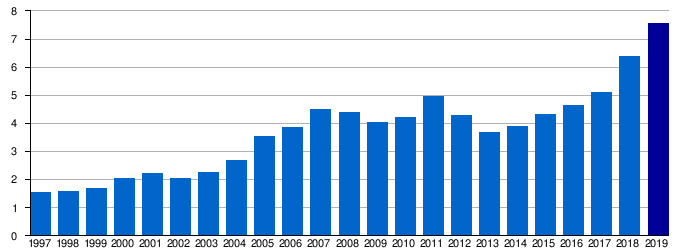 | ||||
| 1998 | 1,595,692 | 21,911 | |||||
| 1999 | 1,688,539 | 23,275 | |||||
| 2000 | 2,037,353 | 25,701 | |||||
| 2001 | 2,205,117 | 38,848 | |||||
| 2002 | 2,042,068 | 36,124 | |||||
| 2003 | 2,269,565 | 38,483 | |||||
| 2004 | 2,678,595 | 44,231 | |||||
| 2005 | 3,521,112 | 55,423 | |||||
| 2006 | 3,871,785 | 58,576 | |||||
| 2007 | 4,507,264 | 65,092 | |||||
| 2008 | 4,392,148 | 65,067 | |||||
| 2009 | 4,051,392 | 55,601 | |||||
| 2010 | 4,224,718 | 54,499 | |||||
| 2011 | 4,959,359 | 56,021 | |||||
| 2012 | 4,292,020 | 48,520 | |||||
| 2013 | 3,687,714 | 41,591 | |||||
| 2014 | 3,884,146 | 42,380 | |||||
| 2015 | 4,308,845 | 46,086 | |||||
| 2016 | 4,624,038 | 45,838 | |||||
| 2017 | 5,108,807 | 48,660 | Source: AENA[15] | ||||
Ground transportation
Public transport
Urban Transport Line of Seville Airport Airport Express connects the bus station ![]()
![]()
Incidents and accidents
- On 20 April 2011 a Vueling Airbus A320-200 EC-GRH operating flight VY2220 with 150 from Barcelona to Seville aborted landing due to the nose gear stuck in a 90 degrees position the aircraft performed a low approach and the aircraft made a safe emergency landing on runway 27.
- The 2015 Seville A400M crash took place near to the airport.
Notes
- Number of passengers including domestic and international.
- Number of movements represents total takeoffs and landings during that year.
References
- Official airport website, in English Archived 2012-03-01 at the Wayback Machine
- Official airport website, in Spanish Archived 2007-11-09 at the Wayback Machine
- "El Aeropuerto de Sevilla cerró 2019 con 7,5 millones de pasajeros - Aena.es". AENA. Retrieved 12 July 2020.
- "Ryanair to open Seville base". examiner.ie.
- "San Pablo cumple 80 años". Diario de Sevilla (in Spanish). 11 July 2013. Retrieved 12 July 2020.
- "Un siglo de historia del acuartelamiento de Tablada". Diario de Sevilla (in Spanish). 27 February 2020. Retrieved 12 July 2020.
- "Unimos Madrid con Asturias y Sevilla". billete996.aireuropa.com.
- https://www.routesonline.com/news/38/airlineroute/285752/air-france-adds-seville-service-from-june-2020/
- "Vigo adjudica a Air Nostrum el nuevo concurso de promoción turística". Europapress.
- Liu, Jim. "Ryanair / Laudamotion S20 network consolidation as of 18JUN20". Routesonline. Retrieved 19 June 2020.
- "Un vuelo directo conectará Sevilla y Estocolmo a partir de febrero".
- Liu, Jim (3 December 2019). "Transavia France launches Montpellier base in April 2020". Routesonline. Retrieved 12 December 2019.
- Liu, Jim. "Volotea outlines post-COVID 19 network expansion in S20". Routesonline. Retrieved 25 May 2020.
- Liu, Jim. "Wizz Air S20 new routes addition as of 09JUN20". Routesonline. Retrieved 10 June 2020.
- "TRÁFICO DE PASAJEROS, OPERACIONES Y CARGA EN LOS AEROPUERTOS ESPAÑOLES – aena-aeropuertos.es" (PDF). aena.es. Archived from the original (PDF) on 5 March 2016.
- "Airport Bus Timetable" (PDF). TUSSAM.es. Archived from the original (PDF) on 16 June 2015. Retrieved 9 August 2015.
External links
![]()